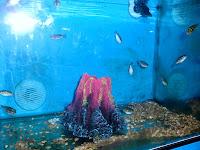Unfortunately, many aquarists learn the hard way that
puffers aren't suitable for community tanks. There are several reasons, but the
most pertinent one is their territorial nature as they mature. Here's a quick
rundown of four of the most compelling reasons why you probably don't want to
keep tankmates with your green spotted puffer:
 |
| GSP do best as single fish |
- Green spotted puffers are brackish fish. High end brackish to be exact. This means that all freshwater and low end brackish fish are ruled out, which are usually the fish that most people want to keep with their GSP.
- They're usually very territorial. The teeth that a green spotted puffer has are intended for crushing hard shelled prey items, like mollusks and crustaceans. The amount of damage that they can do to a soft bodied creature is often mortal provided that they take a chunk out in the right place. Most of the time, these territorial spats happen when the owner isn't looking, which means you'll end up waking up to fish with shredded fins or missing bellies – a situation that can be completely avoided by just refraining from trying to keep your puffer in a community setting.
- They need 30 gallons of water per puffer. All puffers have a high waste output, which means they need ample space for swimming and dilution. If you want to keep multiple GSP, you will need to have at least 30 gallons of water for each one, which means if you decide to just keep two specimens you're already looking at a 60 gallon tank – that's larger than most people want to go for a simple home display.
- It will be difficult to avoid over feeding the tank. If you decide to try to keep tankmates with your green spotted puffer, then you'll find yourself in a catch-22 when feeding time rolls around. GSP definitely shouldn't be kept with slow moving tankmates because of their tendency to fin nip. On the other hand, if you keep them with fast moving fish, then they will never get a chance to eat – you would end up over feeding the fast moving fish just to ensure your puffer got his fill.
On a final note, sometimes it is possible to keep green
spotted puffers in a species tank, which is a tank that is dedicated to a
single species. However, this depends largely on the amount of tank space available
and the individual personalities of the puffers you choose. Additionally, some
people also successfully keep GSP's with other brackish fish of similar salinity
requirements, like monos and scats. Greenspotted puffers are not compatible with Figure 8 puffers; they require a much
higher salinity than Tetraodon biocellatus and because of this, one fish will
end up thriving while the other slowly suffers. The most important thing you can
do if you decide to try to keep other fish with your green spotted puffer is to
have a backup tank on hand that is fully cycled just in case you have to
separate the fish.
Do you have any experiences keeping green spotted puffers
with tankmates? Let me know with a comment!
